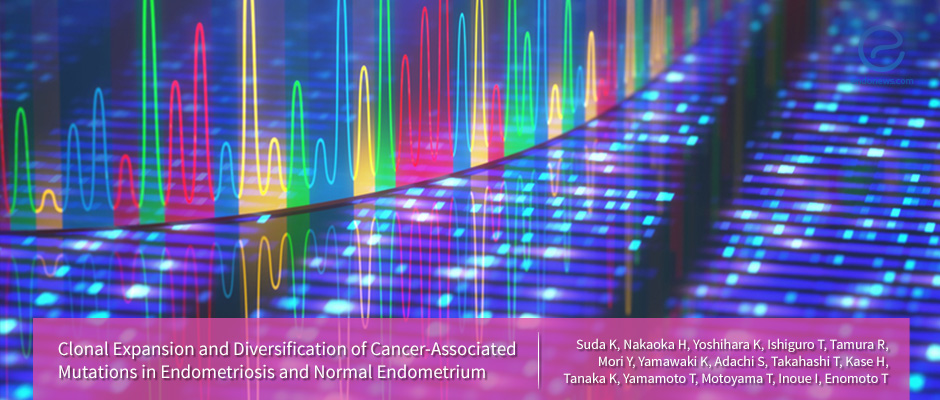Clonal Proliferation and Cancer Associated Mutations in normal uterine endometrium and endometriosis
Feb 11, 2019
Cancer-associated mutations are already present in normal uterine endometrial glands and glands of endometriosis
Key Points
Highlights:
- Somatic cancer-associated mutations are detected even in the histologically benign epithelium of both uterine endometrial glands and endometriosis. There is a clonal expansion of epithelial cells in endometriosis
- Different mutations were identified in different glands of the same uterine endometrium. Also, different mutations were identified in bilateral endometriosis, showing that they arose independently.
- Endometrial tissues with KRAS mutations were transported in a retrograde direction to the ovarian surface. The KRAS mutations gave these cells selective advantage of growth on these ectopic sites to grow into endometriosis.
- These observations support the retrograde menstruation theory, but also concordant with other development theories.
Background:
- There are many theories for endometriosis development (retrograde menstruation, coelomic metaplasia, Müllerian remnants), but none of them have been conclusively confirmed.
- Both in endometriosis without concurrent cancer and in endometriosis with cancer, there are somatic mutations in endometriosis glands. These mutations, are known to be common in endometrioid and clear cell carcinomas of the ovary.
What's Done Here:
- Endometriosis contains epithelial, stromal cells and inflammatory cells. The authors wanted to investigate the mutations in epithelial cells; to get the individual gland epithelia, they used laser microdissection.
- First, a whole-exome sequencing for 13 endometriotic and 11 non-neoplastic uterine endometrial epithelium samples in a discovery cohort. Afterward, targeted-gene sequencing in 94 ovarian endometriotic epithelium samples (from 45 subjects) and 71 non-neoplastic uterine endometrial epithelium (from 29 subjects) with benign gynecologic diseases.
- Authors used the distribution of mutant allele frequencies (MAF) to show how the genomes of endometriosis and normal uterine endometrium evolve through space and time.
Key Results:
- The number of high MAF mutations was larger in endometriotic epithelium than that in the uterine endometrial epithelium.
- There were subsequent mutations which lead to new clone formation and proliferation.
-
- PIK3CA was the most common mutation in uterine endometrium. Mutations are identified even in histologically benign and normal epithelium of both uterine endometrial glands and endometriosis glands;
- KRAS was the most common mutation in endometriosis.
- Different mutations were identified in different glands of the same uterine endometrium.
- Different mutations were identified in bilateral endometriosis, implicating that they arose independently.
Lay Summary
Suda et. al., from Niigata University, Japan, has published the article entitled "Clonal Expansion and Diversification of Cancer-Associated Mutations in Endometriosis and Normal Endometrium" in Cell Reports.

There are many theories for endometriosis development (retrograde menstruation, coelomic metaplasia, Müllerian remnants), but none of them have been conclusively confirmed.
Both in endometriosis without cancer and in endometriosis in continuity with cancer, there are many somatic mutations in endometriosis glands. These mutations, namely PTEN, PIK3CA, and ARID1A, are known to be common in endometrioid and clear cell carcinomas of the ovary.
The authors wanted to investigate the mutations in epithelial cells of non-neoplastic endometrium and endometriosis. They used advanced genetic analysis to form a map of mutations. To get individual glands, they used laser microdissection.
The authors have identified that even in the normal appearing benign endometrial glands, there are cancer-associated mutations. These mutations were different in different glands of the same uterine endometrium. There were also different mutations in bilateral endometriosis, showing that different endometriosis foci arose independently.
They also showed that the frequency of somatic mutations is more common in endometriosis compared to the normal endometrial glands.
These results suggest that the endometrial tissues with KRAS mutations were transported in a retrograde direction to the ovarian surface. The KRAS mutations gave these cells selective advantage of growth on these ectopic sites, and they form endometriosis. With the accumulation of additional mutations, there is a clonal growth.
These observations support the retrograde menstruation theory, but also concordant with other development theories.
Research Source: https://www.ncbi.nlm.nih.gov/pubmed/30110635
clonal evolution endometriosis genomic heterogeneity ovarian cancer mutation

